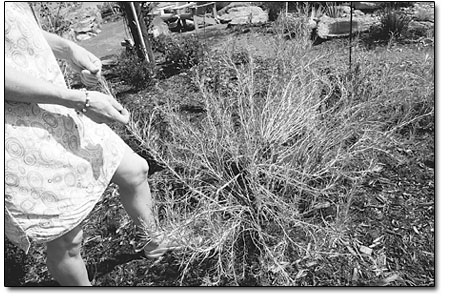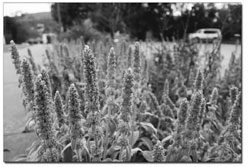| ||||
| Watering down Durango Council to consider Water Efficient Landscape Ordinance SideStory: The root of xeriscaping
by Missy Votel The City of Durango is proposing to tighten the valve on water usage. Next Tuesday, the Durango City Council will consider the newly drafted Water Efficient Landscape Ordinance, which would set guidelines for landscape design in new commercial and multifamily developments. The ordinance would not effect current and existing developments or single-family residences. According to Nancy Andrews, city resource conservation director, the idea for the ordinance was first forwarded during the drought summer of 2002. However, with adequate rain and more pressing issues in subsequent years, the ordinance was back-burnered until being revisited this summer. One of the reasons for this was the passage of the city’s newly revised Comprehensive Plan, which has a sustainability component. “A landscape ordinance is something we’ve wanted to get in place for a few years, and now with sustainability being one of the goals of the Comp Plan, this will support that,” she said. Andrews said similar waterwise landscape ordinances are commonplace in other towns throughout Colorado and the West, including Fort Collins, Albuquerque, Tucson and the Erie-Lafayette suburbs of Denver/Boulder. Jack Rogers, director of public works, said Durango uses three times as much water during summer months as winter months, with much of that additional usage going to irrigation. As the city continues to grow, he said it could be a struggle keeping up with demand. “We decided that with new development coming in, we should provide new developments with standards to reduce city water usage,” he said. While water supply is a concern, the bigger concern is the city’s water treatment plant. Right now, the city’s plant is operating at half capacity, processing 7 million gallons a day in peak summer months, meaning it could potentially double its output. However, the city’s population is projected to nearly triple in coming years. “We need to make our water go as far as it can without having to develop new water supplies and facilities,” he said. “So, the city decided that with all the new developments coming in, we should provide developers with standards to reduce the city’s water usage.” Currently, the city’s annual average consumption per capita is 212 gallons per day. Although the number includes all water used for public facilities, including parks and the Hillcrest Golf Course, as well as the hospital and industry, it is far higher than the average 75 gallons a day used among rural residents, not to mention other municipalities. “Two-hundred and twelve gallons a day is a fairly high number when you look at other communities,” he said.
Rogers said the goal of the ordinance is to reduce the per capita consumption by 10 percent, to 190 gallons per capita, per day, in new development. “In order to do that, we need to make considerable inroads in how we treat community development and outdoor irrigation in general,” he said. Andrews said the City modeled its ordinance on one developed by the Colorado Department of Local Affairs’ Smart Growth Office. “Basically it advocates wise water use such as grouping plants with similar water needs together and watering with the appropriate sprinkler system,” she said. For example, new landscapes plans submitted must incorporate water-efficient irrigation systems that avoid run-off and spraying of nonvegetated areas, such as sidewalks and structures. Furthermore, the irrigation system should correlate with the type of plants being watered. Bubblers or drip hoses would be appropriate for sparsely planted trees and shrubs, whereas sprinkler systems would be reserved for turf. The rules also stipulate that any automated, overhead sprinkler system used in the summer, with the exception of those for establishing newly planted areas, run only between the hours of 7 p.m. - 9 a.m. The new regulations also will incorporate xeriscaping principles and the use of low-water and native plants. Andrews said the city is currently drawing up a plant list that arranges plants according to water usage, ranging from high to moderate, low and very low. She said the list will be based upon the one compiled by the Department of Local Affairs, with some tweaking for Durango’s climate. For example, in the category of turf, Kentucky bluegrass would be ranked high, using up to 20 gallons per square foot over a season, whereas fescues would be ranked moderate, using half as much as bluegrass; and buffalo grass would be ranked ranked low, requiring only a few gallons/square foot. However, Andrews noted that xeriscaping is more of a holistic approach that doesn’t so much rule out turf or higher-water usage plants as it dictates their placement in the landscape’s general scheme. “Xeriscaping really is the whole concept of grouping plants of similar water needs together,” she said. “Turf can be part of it as long as it’s not the whole thing and not next to low-water plants.” Andrews said reception from the professional landscaping community was mixed during a June public meeting on the draft ordinance. “Some thought it was totally unnecessary and another piece of bureaucracy, while others said, ‘This is great. The time has come, and we’re glad to see the city take a stance.’” Regardless, she said they all agreed that another important component of the ordinance should be education. Although it will not apply to most residents, she said they are encouraged to participate as well. “That’s why the education component is so important,” she said. “Although a lot of people are already doing it, we need to be making sure that the information is out there, like watering when it’s cool and calm instead of in the middle of the day.” To that effect, the city will be co-sponsoring a xeriscaping workshop at a yet-to-be-determined date in September. “It will be timely in that it will take place after the ordinance has been adopted and give people a chance to plan ahead for next year,” said Andrews. The ordinance was passed by the Durango Planning Commission in July. If passed by the City Council, Rogers said it could go into effect as early as the second week in September. “If we don’t begin to change now, in the future we’ll be having to find ways to take out Kentucky bluegrass and put in xeriscaping,” he said. •
|
In this week's issue...
- May 15, 2025
- End of the trail
Despite tariff pause, Colorado bike company can’t hang on through supply chain chaos
- May 8, 2025
- Shared pain
Dismal trend highlights need to cut usage in Upper Basin, too
- April 24, 2025
- A tale of two bills
Nuclear gets all the hype, but optimizing infrastructure will have bigger impact



